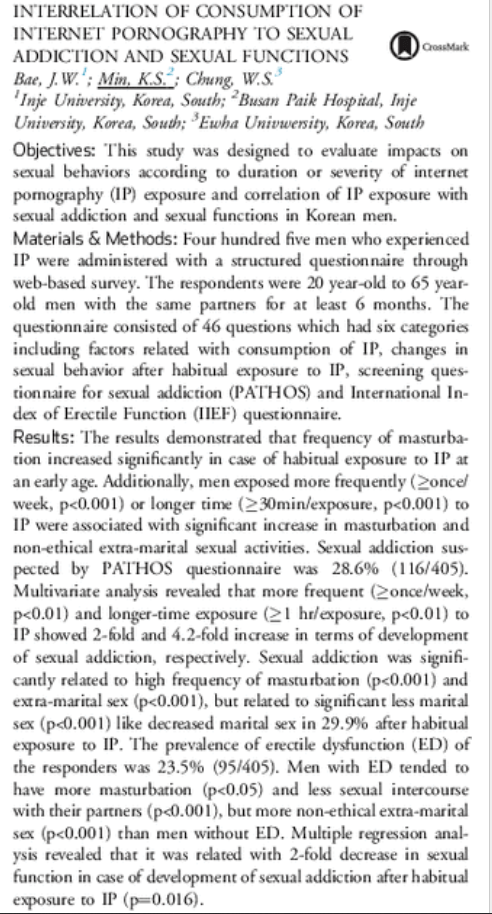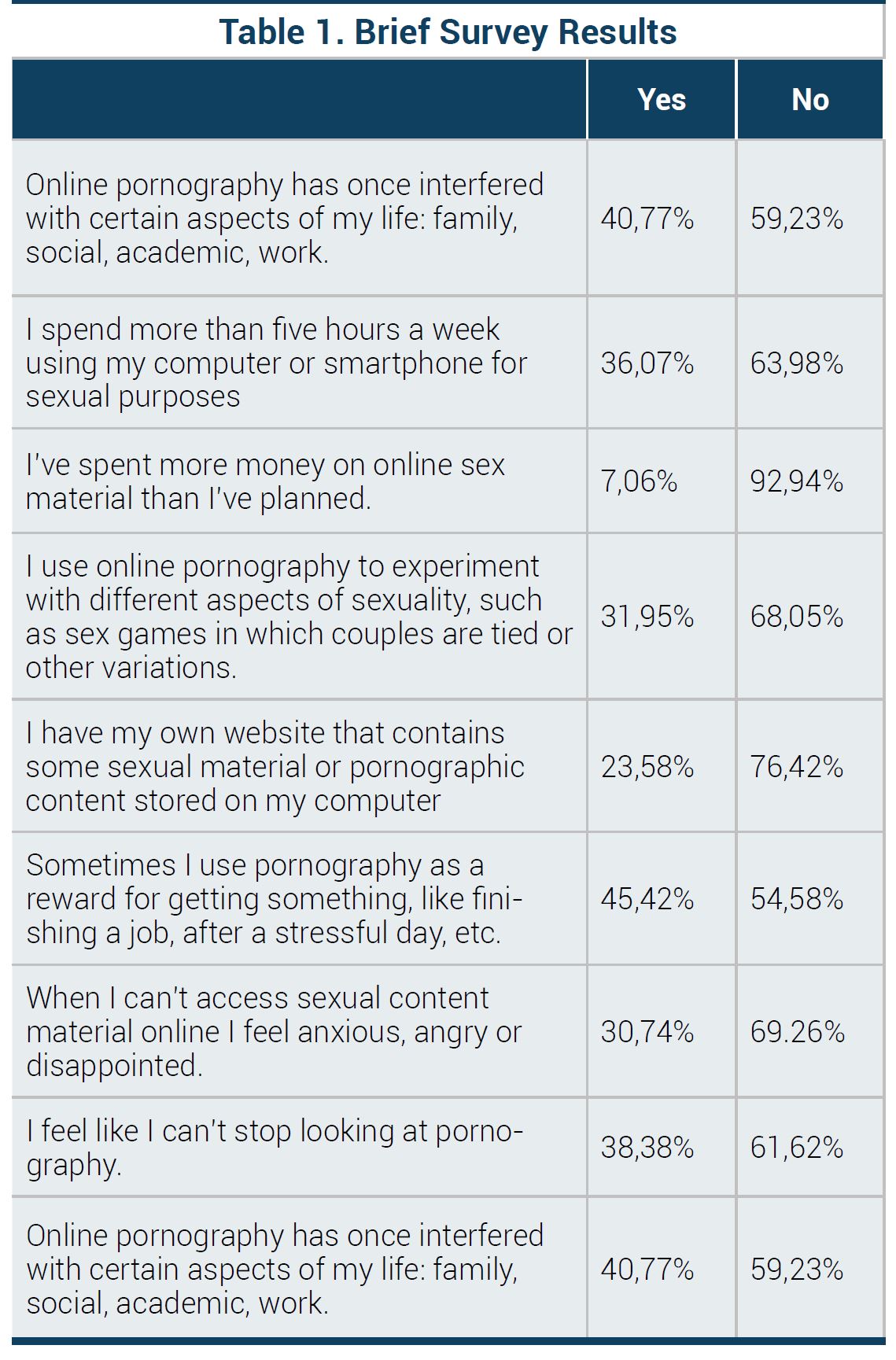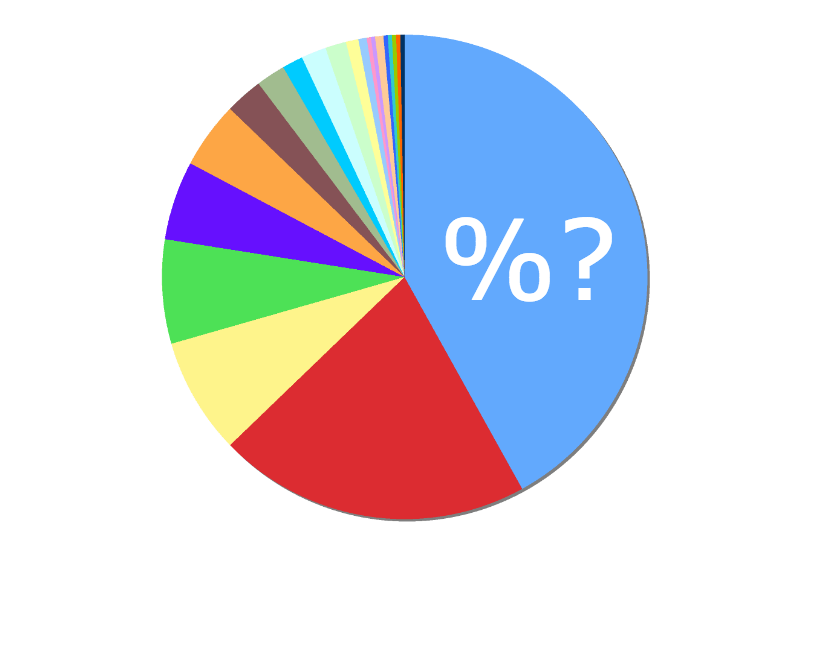Rates of porn addiction, sex addiction or compulsive sexual behaviour disorder in the general population are gradually being revealed by ongoing research.
Pornography: A Concealed Behavior with Serious Consequences (2023)
[Data from n=1022 participants of the Rhode Island Young Adult Survey] 6.2% met the criteria for addiction. Odds of pornography use were 5 times higher (95%CI=3.18,7.71), and addiction 13.4 times higher (95%CI=5.71,31.4) among heterosexual cis-males.
Technological Addictions
The prevalence of problematic cybersex and Internet porn use could be as high as 10%.
Compulsive sexual behavior disorder in 42 countries: Insights from the International Sex Survey and introduction of standardized assessment tools
Almost 5% of participants were at high risk of CSBD in the present study, though estimates varied between 1.6% to 16.7% across countries, genders, and sexual orientations. These estimates are similar to, or slightly higher than in some cases, those reported in previous nationally representative samples in the US, Germany, Hungary, and Poland (Briken et al., 2022; Bőthe et al., 2020; Dickenson et al., 2018; Grubbs et al., 2023; Lewczuk et al., 2022).
On the current psychotherapeutic situation for persons with pornography use disorder in Germany (2023)
The estimated prevalence of Internet Pornography Use Disorder (lPUD) in the online study was 4.7% and men were 6.3 times more often affected than women. [2070 subjects, general population]
Although PUD occurs quite often in Germany, availability of mental health care services for PUD is poor. Specific PUD treatments are urgently needed.
Religiosity, education level, relationship status, well-being or duration of pornography use did not predict demand for therapy.
Withdrawal and tolerance as related to compulsive sexual behavior disorder and problematic pornography use – Preregistered study based on a nationally representative sample in Poland (2022)
In a large nationally representative sample of Polish participants,
Prevalence estimates of CSBD [compulsive sexual behavior disorder, ICD-11] were 4.67% for all participants … including 6.25% of men … and 3.17% of women. Prevalence estimates of PPU [Problematic Porn Use] were 22.84% for all participants … 33.24% for men and 12.93% for women ….
Online sexual activities: An exploratory study of problematic and non-problematic usage patterns in a sample of men (2016)
Volume 56, March 2016, Pages 257–266
COMMENTS: This Belgian study (Leuven) found that 27.6% of subjects who had used porn in the last 3 months self-assessed their online sexual activities as problematic. An excerpt:
The proportion of participants who reported experiencing concerns regarding their involvement in OSAs was 27.6% and of these, 33.9% reported that they had already thought to ask for help for OSA use.
Cybersex Addiction Among College Students: A Prevalence Study (2017)
Sexual Addiction & Compulsivity Pages 1-11 | Published online: 28 Mar 2017 http://dx.doi.org/10.1080/10720162.2017.1287612
Amanda L. Giordano & Craig S. Cashwell
COMMENTS: In a cross-disciplinary survey of students (avg. age 23), 10.3% scored in the clinical range for cybersex addiction (19% of men and 4% of women). It’s important to note that this survey did not limit its participants to porn users. (Two other recent studies on rates of porn addiction limited their sample to subjects who had used porn at least once in the last 3 months or 6 months. Both studies reported addiction/problematic porn use rates of ~28%.)
Clinical Characteristics of Men Interested in Seeking Treatment for Use of Pornography (2016)
J Behav Addict. 2016 Jun;5(2):169-78. doi: 10.1556/2006.5.2016.036.
Kraus SW1,2,3, Martino S2,3, Potenza MN3,4.
COMMENTS: A study on men over 18 who had viewed pornography at least once in the last 6 months. The study reported that 28% of men scored at (or above) the cutoff for possible hypersexual disorder.
Who’s a Porn Addict? Examining the Roles of Pornography Use, Religiousness, and Moral Incongruence
(2017, not yet published, but available in full online: https://psyarxiv.com/s6jzf/)
By Joshua B. Grubbs, Jennifer T. Grant, Joel Engelman (Bowling Green State University)
According to Dr. Grubbs, rates of porn users who answered “yes” to one of the following questions ranged from 8-20% in three diverse samples: “I believe that I am addicted to internet pornography.” or “I would call myself an internet pornography addict.”
Emotion Regulation and Sex Addiction among College Students (2017)
International Journal of Mental Health and Addiction. February 2017, Volume 15, Issue 1, pp 16–27
The study utilized the SAST-R “Core Scale” to assess sexual addiction.Among a sample of 337 college students, 57 (16.9 %) scored in the clinical range of sexual addiction. Breaking this down by gender, 17.8% of males and 15.5% of females in the sample surpassed the clinical cutoff.
Cyber Pornography Addiction Amongst Medical Students of Western Rural Maharashtra (2018)
International Journal of Clinical and Biomedical Research (IJCBR) 3, no. 2 (2017): 10-14.
A prospective cross sectional study was conducted after obtaining an ethical approval from the institute and an informed consent from volunteers fulfilling the eligibility criteria. The Internet sex screening test (ISST) questionnaire with score sheet was used and was collected by complete anonymity and confidentiality. 300 medical students were considered for the study and data collected was analysed by Microsoft-office excel.
Results: 57.15% of the volunteers are in low-risk group whereas 30% are vulnerable and 12.85% are in highest-risk group. For boys, 65% are vulnerable whereas 21% in low-risk and the remaining 14% are in highest-risk group. For girls, 73% are in a low-risk, 19% are vulnerable and 8% are in highest-risk group.
Masturbation and Pornography Use Among Coupled Heterosexual Men With Decreased Sexual Desire: How Many Roles of Masturbation? (2015)
J Sex Marital Ther. 2015;41(6):626-35. doi: 10.1080/0092623X.2014.958790.
Frequent porn was related with decreased sexual desire and low relationship intimacy. Excerpts:
Analyses were carried out on a subset of 596 men with decreased sexual desire (mean age = 40.2 years) who were recruited as part of a large online study on male sexual health in 3 European countries. A majority of the participants (67%) reported masturbating at least once a week.
Among men who masturbated frequently, 70% used pornography at least once a week. A multivariate assessment showed that sexual boredom, frequent pornography use, and low relationship intimacy significantly increased the odds of reporting frequent masturbation among coupled men with decreased sexual desire.
Among men [with decreased sexual desire] who used pornography at least once a week [in 2011], 26.1% reported that they were unable to control their pornography use. In addition, 26.7% of men reported that their use of pornography negatively affected their partnered sex.
COMMENTS: Stats were for a subset of men with decreased sexual desire: 26.1% reported that they were unable to control their pornography use
Interrelation of Consumption of Internet Pornography to Sexual Addiction and Sexual Functions (2018)
[Abstract from Journal of Sexual Medicine only is available so far. See image below]

...Sexual addiction suspected by PATHOS questionnaire was 28.6% (116/405 [total subjects who had ever viewed porn])
Co-occurring substance-related and behavioral addiction problems: A person-centered, lay epidemiology approach (2016)
J Behav Addict. 2016 Dec;5(4):614-622. doi: 10.1556/2006.5.2016.079.
Background and aims: The aims of this study were (a) to describe the prevalence of single versus multiple addiction problems in a large representative sample and (b) to identify distinct subgroups of people experiencing substance-related and behavioral addiction problems.
Methods: A random sample of 6,000 respondents from Alberta, Canada, completed survey items assessing self-attributed problems experienced in the past year with four substances (alcohol, tobacco, marijuana, and cocaine) and six behaviors (gambling, eating, shopping, sex, video gaming, and work). Hierarchical cluster analyses were used to classify patterns of co-occurring addiction problems on an analytic subsample of 2,728 respondents (1,696 women and 1032 men; Mage = 45.1 years, SDage = 13.5 years) who reported problems with one or more of the addictive behaviors in the previous year.
Results: In the total sample, 49.2% of the respondents reported zero, 29.8% reported one, 13.1% reported two, and 7.9% reported three or more addiction problems in the previous year. Cluster-analytic results suggested a 7-group solution.
COMMENTS: This study assessed the self-reported rates of substance and behavioral addictions in a representative sample of Canadians. It’s important to note that self assessment would tend to under report addiction rates. The findings: about 4.8% thought they had a “sex addiction” (in reality, 9.5% of the group that had at least one addiction thought their primary addiction was porn or sex). The excerpt describing addiction rates:
Classifying co-occurring addiction problems
The results of the cluster analysis suggested a seven-cluster solution. As shown in Table 5, the first cluster (26.0% of the sample used when conducting the clustering) represented individuals with smoking as their shared problem behavior. The second cluster (21.8%) consisted of participants reporting excessive eating as their only problem behavior. The third cluster (16.2%) represented individuals with work problems, while the fourth cluster (13.0%) consisted of participants characterized by a large number of different addiction problems without a clearly dominant behavior.
The fifth cluster (9.5%) represented mainly individuals reporting excessive sexual behavior, while the sixth (8.9%) and seventh (4.7%) clusters consisted of participants with shopping and video gaming as their shared behavioral problem, respectively. Highest average number of past-year addictive behaviors was observed among excessive video game players (Cluster VII), while the lowest was found among excessive eaters (Cluster II). Detailed information on the addiction characteristics of each cluster are described in Table 5.
A few possible reasons why the rate wasn’t higher:
- The average age was 44
- Only 38% of the subjects were males
- The survey was done in 2009
- Most porn users fail to recognize the negative effects related to their porn use or that the signs and symptoms of an addiction.
Technology addiction among treatment seekers for psychological problems: implication for screening in mental health setting (2017)
The mean age of the sample was 26.67 with the standard deviation of 6.5. The age distribution was 16 years to 40 years. The sample had 45 males (60%) and 30 females (40%). 17 were married (22.67%), 57 were unmarried (76%), and 1 was divorced (1.33%). All the subjects had 10 and more year of education. 36% were from the rural area and the 64% were from the urban area.
In Table 3, Type of Addiction, Pornography Addiction was as follows:
- Proneness to addiction: 8%
- High risk to addiction: 6.7%
- Addicted to pornography: 4%
Self-Reported Addiction to Pornography in a Nationally Representative Sample: The Role of Religiousness and Morality (2018), in press
Average age 49, only included those who had ever viewed pornography. Self-reported pornography addiction was measured using a simple question: “I am addicted to Internet pornography”. Excerpts:
The present study sought to examine self-reported pornography addiction in a U.S. nationally representative sample of adult internet users (N=2,075).
Results: Results indicated that the majority of the sample had viewed pornography within their lifetimes (n = 1,466), with just over half reporting some use in the past year (n = 1,056). Moreover, roughly 11% of men and 3% of women reported some agreement with feelings of pornography addiction.
Across all participants, such feelings were most strongly associated with male gender, younger age, greater religiousness, greater moral incongruence regarding pornography use, and greater use of pornography.
Key finding: Frequency of porn use was by far the strongest predictor of believing oneself addicted to porn (twice as strong as religiosity).
Pattern of Smart Phone and Internet Usage among Medical Students in Surat, Gujarat – A Cross Sectional Study (2018)
Excerpt related to porn use:
About 62.7% of the boys and 5.2% of the girls watched porn material on their mobile. 21.7% [male medical students] were addicted to watch porn material on their mobile. About 12.4% boys and 1.9% girls stated that watching porn affects their study.
About half of the participants felt addicted to internet.
Understanding and predicting profiles of compulsive sexual behavior among adolescents (2018)
Excerpts:
A total of 1,182 Israeli school students, consisting of 500 boys (42.30%) and 682 girls (57.70%) … aged 14–18 years ….
… The third group was classified as CSBs comprising 12.0% of the sample (n = 142).
Specifically, adolescents with CSB and/or sexual fantasizers were more likely boys (73.8% and 70.5%, respectively)….
[Approximately 72% of those with CSB were boys, which means the rate of CSB among male subjects was ~20% and <6% among female subjects.]
Prevalence of Distress Associated With Difficulty Controlling Sexual Urges, Feelings, and Behaviors in the United States (2018)
 COMMENTS: Under emphasizes the problems in those who are most at risk (millennial male group), including those who were under 18 when the survey was taken and who grew up on smartphones and porn tube sites. Excerpts:
COMMENTS: Under emphasizes the problems in those who are most at risk (millennial male group), including those who were under 18 when the survey was taken and who grew up on smartphones and porn tube sites. Excerpts:
Participants between the ages of 18 and 50 years were randomly sampled from all 50 US states in November 2016. [Mean age 34]
…In this survey study [which asked about compulsive sexual behavior], we found that 8.6% of the nationally representative sample (7.0% of women and 10.3% of men) endorsed clinically relevant levels of distress and/or impairment associated with difficulty controlling sexual feelings, urges, and behaviors.
…The high prevalence of such symptoms has major public health relevance as a sociocultural problem and indicates a significant clinical problem that should be recognized by health care professionals.
… Of 2325 adults (1174 [50.5%] female; mean [SD] age, 34.0 [9.3] years), 201 [8.6%] met the clinical screen cut point of a score of 35 or higher on the Compulsive Sexual Behavior Inventory.
…With regard to demographic characteristics, we found that individuals with lower education, those with very high or very low income, racial/ethnic minorities, and sexual minorities were more likely to meet the clinical cut point than individuals who reported having higher education, having moderate income, and being white and heterosexual.
Frequency and Duration of Use, Craving and Negative Emotions in Problematic Online Sexual Activities (2019)
[China, with US collaborator] Excerpt:
Data from 1070 college students suggested that 20.63% of students were at risk of problematic OSAs use, and this group had greater frequency of OSAs, more usage time, higher pornography craving and more negative academic emotions.
21% of Chinese college students (male and female) at risk for problematic online sexual activity. Frequency predicted more problems than duration of viewing.
How do your porn habits compare with young people across Britain? (large BBC survey)
Although 47% of all respondents were comfortable with the amount of porn they watched, 15% of men thought they watched too much, compared with 5% of women. Some 31% of men felt they’d been addicted to porn, but only 14% of women said the same.
Consequences Of Pornography Use: Brief Report (2019)
[PDF can be downloaded at above link.] Spanish-speaking subjects.

A Profile of Pornography Users in Australia: Findings From the Second Australian Study of Health and Relationships (2016)
COMMENTS: Some claim this study supports the argument that Internet porn doesn’t really cause serious problems. For example, only 4% of the men felt they were addicted to porn. There are reasons to take the headlines with a grain of salt.
Check out the study’s conclusion:
Looking at pornographic material appears to be reasonably common in Australia, with adverse effects reported by a small minority.
However, for participants aged 16-30, it’s not such a small minority. According to Table 5 in the study, 17% of this age group reported that using pornography had a bad effect on them. (In contrast, among people 60-69, only 7.2% thought porn had a bad effect.)
How different would the headlines from this study have been if the authors had emphasized their finding that nearly 1 in 5 young people believed that porn use had a “bad effect on them”? Why did they attempt to downplay this finding by ignoring it and focusing on cross-sectional results – rather than the group most at risk for internet problems?
A few caveats about this study and the rates it revealed:
- This was a cross-sectional representative study spanning age groups 16-69, males and females. It’s well established that young men are the primary users of internet porn. So, 25% of the men and 60% of the women had not viewed porn at least once in the last 12 months. Thus the statistics gathered minimize the problem by veiling the at-risk users.
- The single question, which asked participants if they had used porn in the last 12 months, doesn’t meaningfully quantify porn use. For example, a person who bumped into a porn site pop-up is considered no different from someone who masturbates 3 times a day to hardcore porn.
- However, when the survey inquired of those who “had ever viewed porn” which ones had viewed porn in the past year, the highest percentage was the teen group. 93.4% of them had viewed in the last year, with 20-29 year olds just behind them at 88.6.
- Data was gathered between October 2012 and November 2013. Things have changed a lot in the last 4 years, thanks to smartphone penetration – especially in younger users.
- Questions were asked in computer-assisted telephone interviews. It’s human nature to be more forthcoming in completely anonymous interviews, especially when interviews are about sensitive subjects such as porn use and porn addiction.
- The questions are based purely upon self-perception. Keep in mind that addicts rarely see themselves as addicted. In fact, most internet porn users are unlikely to connect their symptoms to porn use unless they quit for an extended period.
- The study did not employ standardized questionnaires (given anonymously), which would more accurately have assessed both porn addiction and porn’s effects on the users.
Once again, few regular porn users realize how porn has affected them until well after they cease using. Often ex-users need several months to fully recognize the negative effects. Thus, a study like this one has major limitations.
Cybersex-addiction among young people: clinical, psychopathological, social and psychological aspects (2018)
[Russia] Excerpt:
The average age of students was 22,0 ± 1,1 years old. Pathological passion to porn sites identified in … (5.7%) among males (p<0,007) [and] females (0.9%).
Problematic Pornography Use in Japan: A Preliminary Study Among University Students (2021)
24% answered “yes” to having impaired control of their porn use, and 4 out of 5 of those were male. Yet only 6% answered “yes” to “Have you faced daily-life problems due to difficulty in controlling pornography use?” How could a college student assess if porn use had caused problems unless they took a long break? They couldn’t.
Rates: more than 80% of males seeking treatment for CSBD report problems with pornography.
- J. Castro-Calvo, V. Cervigón-Carrasco, R. Ballester-Arnal, C. Giménez-García, Cognitive processes related to problematic pornography use (PPU): A systematic review of experimental studies, Addictive Behaviors Reports, Volume 13, 2021,
100345, ISSN 2352-8532, https://doi.org/10.1016/j.abrep.2021.100345.
Excerpt: Wéry et al. (2016) found that 90.1% of a sample of 72 self-identified sexual addicts reported PPU as their primary sexual problem. This finding resonates with results from the DSM-5 field trial for HD (Reid et al., 2012), in which 81.1% of a sample of 152 patients seeking treatment for this condition reported PPU as their primary problematic sexual behavior. Conversely, Bőthe et al. (2020) found that individuals categorized as problematic pornography users through a data-driven approach scored systematically higher in a measure of HD; indeed, scores in this scale better discriminated between highly engaged but not problematic and problematic pornography users than any other variable (including the frequency of pornography use).
- Mateusz Gola, Poland, with E. Kowalewska, M. Wordecha, M. Lew-Starowicz, S. W. Kraus, and M. N. Potenza, Findings from the Polish Compulsive Sexual Behavior Disorder Field Trial, Conference: 5th International Conference on Behavioral Addictions (ICBA 2018): Cologne, Germany
Excerpt: We examined the characteristics of individuals seeking treatment for CSB. Methods: Questionnaire data were collected from 847 individuals (811 male, 36 female) voluntarily seeking psychological and psychiatric treatment for CSB in Poland. Results: Pornography use and masturbation was cited as problematic in 91% of individuals, risky sexual behaviors with other people in 21%, and paid sexual services use in 13%. … More than four-fifths (82 %) of individuals met proposed ICD11 CSBD criteria.
- Reid, R. C., Carpenter, B. N., Hook, J. N., Garos, S., Manning, J. C., Gilliland, R., … Fong, T. (2012). Report of findings in a DSM‐5 field trial for hypersexual disorder. The Journal of Sexual Medicine, 9, 2868–2877. doi:10.1111/j.1743-6109.2012.02936.x
81.1% of a sample of 152 patients seeking treatment for this condition reported PPU as their primary problematic sexual behavior
- A. Wéry, K. Vogelaere, G. Challet-Bouju, F.-X. Poudat, J. Caillon, D. Lever, …, M. Grall-Bronnec, Characteristics of self-identified sexual addicts in a behavioral addiction outpatient clinic, Journal of Behavioral Addictions, 5 (4) (2016), pp. 623-630, 10.1556/2006.5.2016.071
90.1% of a sample of 72 self-identified sexual addicts reported PPU as their primary sexual problem.
- Mead D, Sharpe M. Pornography and sexuality research papers at the 5th International Conference on Behavioral Addictions. Sexual Addiction & Compulsivity. 2018:Oct 2;25(4):248-68. https://doi.org/10.1080/10720162.2019.1578312
Research shows that over 80% of the people seeking treatment for compulsive sexual behaviour disorder have reported an inability to control their use of pornography, despite negative consequences [28, 30, 37,38,39,40].
- Predictors of Compulsive Sexual Behavior Among Treatment-Seeking Women
Of 674 women seeking treatment for CSB, 73.3% (n = 494) had problematic porn use [porn addiction].
__
More details from “Findings from the Polish Compulsive Sexual Behavior Disorder Field Trial”
This study examined in a large Polish sample the proposed definition of Compulsive Sexual Behavior Disorder (6C72) in the draft of ICD-11. In particular, among those seeking treatment for CSB, the criteria proposed for ICD-11 CSBD were examined, as were relationships with constructs such as sex addiction and hypersexual disorder. Screening tests were also examined, as were characteristics of people seeking treatment for CSB.
Recruitment of test subjects through Polish media resulted in 1,812 treatment seekers, with 93% being male, 86% reporting problems with pornography, 87% reporting problems with masturbation, 18% having concerns relating to casual sex, and 12% having concerns relating to paid sexual activities. The sample had a mean age of 35.69 years (SD = 9.78).
In the sample, 50% to 72% of people interested in treatment for CSB met criteria proposed for ICD-11 for CSBD. The most common problematic behaviors included pornography viewing and masturbation. Screening tools such as the Hypersexual Behavior Inventory, the Sexual Addiction Screening Test, and the Brief Pornography Screener (BPS) appeared to perform well. When compared to the group who failed to meet the criteria for CSBD diagnosis under ICD-11, the individuals meeting the criteria experienced more primary and secondary negative impacts on their life, especially in the areas related to relationships.
